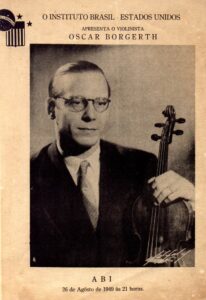- The Brazil-USA Institute (IBEU) presents, at the ABI (Brazilian Press Association) Auditorium, a concert in which the Sonatina for Violin and Piano [1] by Radamés Gnattali, with Oscar Borgerth on violin and the author on the piano.

- The Theatro Municipal do Rio de Janeiro presents, in its National Art Season [2], a concert entirely dedicated to the work of Radamés. On the program:
Concerto for Cello and Orchestra
(1941) – soloist, Iberê Gomes Grosso;
Concerto Romantico for piano and orchestra
(1949) – soloist, the author;
Three miniatures for orchestra
(1940) e
Brasiliana no. 1
(1944), both for orchestra; conductors, Leo Peracchi and Radamés Gnattali.


Correio da Manhã (RJ) >
“Radamés Gnattali Festival” –
by Eurico Noqueira França
Romantic Concerto for piano and orchestra
I – Allegro (excerpt)
National Symphony Orchestra
Alceo Bocchino, conductor
Radamés Gnattali, piano
SOARMEC – S-004 (1997)
- The recording company Continental releases Radamés Gnattali’s samba-canção, foreshadowing bossa nova.
Late Afternoon
performed by the Continental Quartet, formed by José Menezes (guitar), Radamés (piano), Pedro Vidal (bass) and Luciano Perrone (drums). Still this year, Continental will release Radamés’ choro
Chat
and the waltz
Caminho da saudade (Path of homesickness)
performed by Zé Bodega (José de Araújo Oliveira, sax-tenor), Radamés (piano) and Luciano Perrone (drums). - Radamés composes:
- Brasiliana no. 4 for piano – dedicated to Heitor Alimonda
- Concerto Romântico – for piano and large orchestra
Concerto Romântico – for two pianos
(transcription of the orchestral part for the second piano)- Variations on a series of sounds for violin and piano, with chamber orchestra
- Companhia Cinematográfica Vera Cruz is founded and the Cinédia studios close.
- Getúlio Vargas launches himself as a candidate for the Presidency of the Republic.
